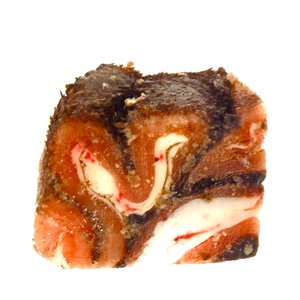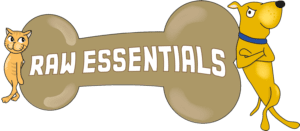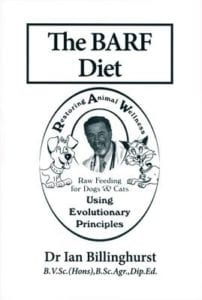Dogs, Food and History: For thousands of years, dogs roamed the ancient world living on the Savannahs of Africa, the plains of India and the forests of Europe, Asia and the Americas. Their food came from three sources: prey, scavenged and grazed items. Prey would mainly consist of herbivores such as rabbits, deer, sheep or antelope. Scavenged food included the scraps left over from the meals of big carnivores such as lions and bears. Grazed food included apples, berries and other wild fruits and nuts in season forming a small but significant part of a dog’s diet.
Dogs hunted in packs. They devoured their prey completely including the gut contents which would be full of partially digested vegetable matter. Cereals were also present, but only in small amounts. The bones, skin and hair comprised the final course, being nature’s way of cleaning the teeth after a large meal.
Man has been feeding dogs for about forty thousand years. The canines helped with the hunt and man rewarded them with some of the leftovers. Life was easier for both species under this arrangement.
Commercial Diets:
Today we find ourselves tempted by the convenience of, and advertising for a large array of pet foods, both tinned and dry. With such a large choice we sometimes don’t know where to turn. Initially, the pet food market was an outlet to sell poor quality meat, gristle ,viscera and cereal by-products not fit for human consumption. More recently there has been a big drive by some manufacturers to create the perfect biscuit diet, however, no matter how high the quality of the ingredients used to manufacture these foods, there is one step that cannot be omitted – the need for processing, and cooking. This changes the nature of the proteins from their natural form, destroys vitamins which have to be added back artificially and in the case of biscuits removes the moisture which would have been normal constituent of a raw diet.
This can result in symptoms such as persistent itch or eczema, dental problems or smelly breath, allergies, inflammatory bowel disease, food hypersensitivity, lethargy, dull and scurfy coat, and arthritis.
Raw Food:
Dogs can thrive on a raw diet: raw meat, and meaty bones, offal plus green tripe or liquidized raw fruit and vegetables. Here’s how a raw diet works:
The Rules:
-
- Dogs should be fed on a variety of protein sources: Just sticking to one meat source will deprive your dog of nutrients. Aim to feed three different types of proteins over the period of a week. If your dog has a skin or bowel problem, do not initially feed beef; wait until you are sure that it won’t cause a reaction (4 weeks), and then introduce gradually. Do not feed pork. Choose special pet minces which are minced including the bone for a more balanced diet, and source frozen to make sure there are not additives and preservatives.
- Raw meaty bones: such as chicken and rabbit frames, chicken wings, lamb ribs, and ox tails can also be fed as a meat source two or three times a week and are ideal for small dogs and puppies over 5 weeks. They provide an invaluable source of calcium and other minerals and vitamins, in addition to maintaining dental health. Feed meaty bones appropriate to the size of your pet to avoid them gulping them down in one piece e.g. a chicken wing of neck may suit a small Jack Russell but the whole chicken frame would be best for a larger dog such as a Labrador.
Never give cooked bones: they are prone to splinter and are extremely difficult to digest, possibly causing blockages or constipation. Raw meaty bones are easily chewed and digested as they still contain some moisture and are softer than cooked bones.
Never give cut bones: bones that have been cut leave sharp edges which a dogs teeth can get purchase on. This leads to an un-natural biting surface and can result on fractures of the teeth. - Feed green tripe or liquidized raw fruit and vegetables: Green tripe is an invaluable source of pre and probiotics, digestive enzymes, fatty acids and fibre, all required to maintain the health of the gut and considered a
 super food for carnivores. Green tripe should make up between 1/4 to 1/3 of the diet and be given daily. It tends to be laxative in nature so adjust so that stools are normal.
super food for carnivores. Green tripe should make up between 1/4 to 1/3 of the diet and be given daily. It tends to be laxative in nature so adjust so that stools are normal.
Green tripe can smell quite strong which dogs often love, but if you cannot face the smell you can replace tripe with liquidized raw fruit and vegetables such as broccoli, carrot, leafy greens, and small amounts of fruit. Ensure a variety of vegetables week by week. A juicer is ideal as dogs teeth are not efficient at grinding vegetables and liquidizing helps release important vitamins. The juice and the pulp can be added to the minced meats.
Do not feed avocado stones, corn cobs or mango pips, and grapes, raisons and onions should not be fed. - Feed offal: organ meats such as heart, liver and kidney are rich in vitamins and minerals. These need to be given 1-2 times per week or in small amounts daily to match the proportion that they would be found in a carcass. Offal can be laxative in effect and quite rich so do not give too much. In animals with organ problems (liver, heart or kidney disease) it can be useful to make a point in feeding a little offal to match your animals weakness e.g if there is liver disease feed a little liver.
- Do not mix cereal based and dry dog diets with raw diets: Dogs fed a balanced raw diet have more acidic stomach contents than those fed on biscuits. This combined with the presence of anti-bacterial salivary enzymes and a short gut means it is very unlikely harmful bacteria survive after ingestion. The high stomach acidity also assists in digestion of the bone avoiding the risk of an obstruction.
Grain fed dogs given the occasional bone are more likely to run into trouble with digestive problems. Also feeding biscuits with bones causes the stomach contents to become unnaturally dry. This is a common cause of serious constipation seen by veterinarians. - Daily quantities of raw meat : the general rule is to feed 2% of the dogs body weight (for every 10kg of ideal body weight feed 200gm of food). This is only a guideline to start: if your dog is gaining weight, reduce the quantity; if it is losing weight, increase it. Puppies will need on average 6% of their body weight with some very active puppies requiring up to 10%.
- Treats can include baked liver cubes, small amounts of freeze-dried meats, fruit and vegetable portions or dried fruit (not raisins).
Extra supplements: if the diet has a lot of variety then additional supplements should not be necessary. However if you feel the need to add something or your dog suffers from a particular illness then there may be supplements that would benefit. Please discuss this further with Dr. Wendy Dixon.
Troubleshooting:
If you cannot bear to feed raw meat, very quick cooking in olive oil to ‘seal’ the juices is ok. Meat should be rare when served.
If your dog has suffered from any chronic diarrhoea of vomiting prior to starting on raw feeding, it is recommended to start with bone broths to assist in the healing of the bowel and simple poached meats. Once these are being digested well some raw minces can be added and finally after a few months raw meaty bones. For any issues please speak with Dr Wendy Dixon.
Can raw meat cause health issues?
- Sourcing high quality food from the human food-chain and ensuring that it has been adequately frozen + feeding in a sensible manner will reduce the risks. In terms of human health, pet owners should apply the same hygiene standards that they employ when dealing with food intended for their own consumption.
- Interestingly there have been numerous recalls of branded biscuits due to contamination with salmonella, and some of these have found to be a cause of human illness requiring hospitalization. The same cannot be said for raw feeding at this point.
Further information:
This advice sheet has been made with the help of information from Lyn Thompson at www.rawessentials.co.nz. More information about raw feeding and holistic health matters can also be found by speaking to Wendy Dixon at New Plymouth Vet Group (06) 758 4006 or St Aubyns Veterinary clinic (06) 751 3000.
Useful books to read:
The bible for all those interested in feeding raw food to cats and dogs for both beginners and the experienced.
Raw Meaty Bones: Promote Health by Tom Lonsdale
A peer reviewed and fully referenced book of information on raw feeding for pet owners and veterinarians. Tom Lonsdale a veterinary expert on species appropriate nutrition.
Content updated 26.02.19



